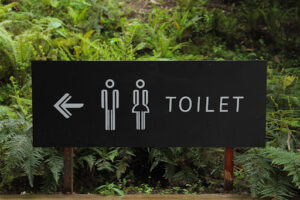Navigating the World of Universal Symbols: Understanding the Language of Icons
If you’re in a foreign country and you desperately need to go to the bathroom, what do you do?
Luckily, most signs showing where the restrooms are have the same recognizable symbols that we see on restroom doors here in the US. These simple silhouettes of a man and a woman are but one of a vast collection of universally recognized symbols that are used all over the world. But where did these symbols come from?

The mind behind universal signs
The American Institute of Graphic Arts – more commonly known as AIGA – is credited with being responsible for establishing these (or at the very least cementing the sign designs). Working together with the US Department of Transportation, AIGA planned to produce 50 standard symbol signs to be used in transportation hubs such as airports as well as at events with a potential large international attendance. The first 34 of these were published in 1974, and received a prestigious Presidential Design Award – one of the first – for their ingenuity. In 1979, the remaining 16 symbols were released, thus reaching 50 until today.
The project’s primary aim was to ensure that the universal signs and symbols located thereon could convey a variety of potentially complex messages. This was meant for people of all different ages and cultures in a format that everybody could easily interpret. A committee formed of five leading designers of environmental graphics oversaw the process, providing recommendations and suggesting and implementing adaptations and redesigns where necessary.
Roger Cook and Don Shanosky are credited as the symbols’ definitive designers, but they can hardly be accused of profiting from their work: the symbols are copyright-free and are now available online for even greater ease of use. The Noun Project also supplies a number of additional universal symbols on their site, which are also completely free of charge.
Universal Symbols: Talk is overrated?
While universal symbols are indeed designed to be understood across cultures, relying solely on them to navigate a foreign country can be quite challenging. While some essential symbols like the above mentioned restroom sign or directional arrows might be straightforward, more nuanced information or specific instructions might not be effectively conveyed through symbols alone. Additionally, local variations or interpretations of symbols could also cause confusion.
In practical terms, it is good to have some basic knowledge of the local language or carry a phrasebook, especially in situations where more detailed communication is necessary. While many people in popular tourist destinations might speak English, making an effort to communicate in the local language can often lead to more meaningful interactions and a smoother experience. Ultimately, while universal signs can provide helpful guidance, combining them with language skills offers a more comprehensive way to navigate in a foreign country.
